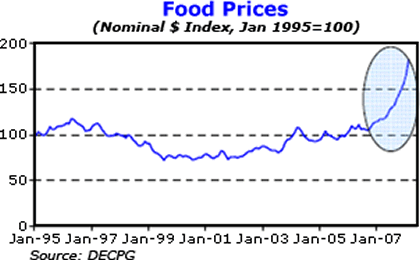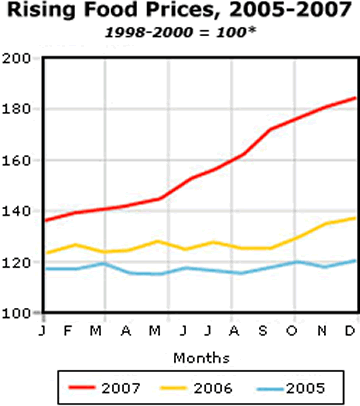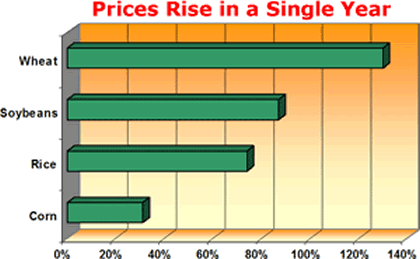Global Food Crisis- How to Protect Your Portfolio
Commodities / Agricultural Commodities Apr 17, 2008 - 09:32 AM GMT Sean Brodrick writes: The United Nations' Food and Agriculture Organization (FAO) said that world cereal production may jump a record 2.6% this year as farmers boost plantings.
Sean Brodrick writes: The United Nations' Food and Agriculture Organization (FAO) said that world cereal production may jump a record 2.6% this year as farmers boost plantings.
In other words, supply is fine.
Except ... wait a minute ... what's that other report I read last month? The one that said world cereal demand is growing at 3% a year.
Today, I'll explain why this seemingly insignificant gap between supply and demand scares the bejeezus out of me, and how you can protect yourself.
The gap is only four-tenths of a percent. What could possibly go wrong, you ask?
Well, for starters ...
The World's Food Supplies Have Collapsed ...
 Worldwide stockpiles of cereals (wheat, corn, etc.) are expected to fall to a 25-year-low of 405 million tonnes in 2008. That's down 21 million tonnes, or 5%, from their already reduced level last year.
Worldwide stockpiles of cereals (wheat, corn, etc.) are expected to fall to a 25-year-low of 405 million tonnes in 2008. That's down 21 million tonnes, or 5%, from their already reduced level last year.
U.S. wheat stockpiles are at a 62-year low, even though farmers are planting from fence-to-fence. And with the U.S. dollar falling fast, foreign buyers are lining up to scoop up as much of Uncle Sam's grain as they can carry away. Wheat recently soared to the highest price in 28 years.
Meanwhile rice, a staple food for three billion people, is becoming increasingly scarce. World stores of rice have shrunk from 130 million tons eight years ago to today's stockpile of 72 million tons — enough for only 17% of annual global demand. Result — the price of rice is up 70% in the past year.
And as for corn — well, more and more of that is used for ethanol. The price of corn is up over 70% in the past year and has more than doubled in the past two years.
So to summarize — stockpiles are at record lows. The supply on hand can be measured in days ! And growth in production can't keep up with growth demand.
Now, let me ask you this question ...
What If Something Goes Wrong?
What if the increasingly freaky weather the world has been enduring causes droughts on one side of the world and floods on the other? What if there's blight or some other major crop failure?
 |
You can see why I believe we are one bad harvest away from a serious global food crisis!
People will put up with a lot, but they won't put up with going hungry ... not when they have guns. In fact, blood is already being spilled over food ...
![]() Egypt — food riots! In the time of Julius Caesar and Cleopatra, Egypt was the bread basket of the Mediterranean. Boy, how times have changed. Food inflation is so bad in Egypt that people are rioting over sky-high prices. The government-owned Egyptian Gazette newspaper says that seven people have died since the beginning of the year in brawls in bread lines.
Egypt — food riots! In the time of Julius Caesar and Cleopatra, Egypt was the bread basket of the Mediterranean. Boy, how times have changed. Food inflation is so bad in Egypt that people are rioting over sky-high prices. The government-owned Egyptian Gazette newspaper says that seven people have died since the beginning of the year in brawls in bread lines.
And it's not just Egypt. The World Bank says 33 countries from Mexico to Yemen have already experienced unrest because of spiraling food costs, and 37 countries may face more social upheavals if food prices continue to rise.
![]() China says "no" to hungry Filipinos. The Philippine government recently asked China to provide 200,000 metric tons of milling wheat, equivalent to about 10% of annual consumption. Beijing declined, leaving the Philippines scrambling to find more wheat.
China says "no" to hungry Filipinos. The Philippine government recently asked China to provide 200,000 metric tons of milling wheat, equivalent to about 10% of annual consumption. Beijing declined, leaving the Philippines scrambling to find more wheat.
![]() Trouble in Uncle Sam's breadbasket. Cold weather is chilling the fields in the Midwest, and too much rain is sending rivers near their flood levels. Farmers who try to till or plant in soils that are too wet will risk compacting their crops and other problems that result in lower yields. On my blog last week, I published a note from a farmer who complained that he STILL can't get a crop in the ground:
Trouble in Uncle Sam's breadbasket. Cold weather is chilling the fields in the Midwest, and too much rain is sending rivers near their flood levels. Farmers who try to till or plant in soils that are too wet will risk compacting their crops and other problems that result in lower yields. On my blog last week, I published a note from a farmer who complained that he STILL can't get a crop in the ground:
"In 2006, we finished planting my crops on April 23. In 2007, we were done on April 18. I don't want to be the first guy planting, but I don't like being third, either. Early (timely) planting won't happen this year if the weather forecast for the coming weekend proves accurate. Soils are completely saturated to the point of that erosion has already occurred and will get worse with additional heavy rains, and are COLD. I can't tell you how cold because I've not even checked temps yet. If planting is not done by May 1, there will be some nervous farmers in LaSalle County and I'll be one of them."
Now sure, that's a local story, but it's not the only one. In fact, just this week, the USDA reported that corn and rice plantings are being delayed by excessive rain. A hungry world is depending on a good U.S. crop — if we don't get one, those 37 countries the World Bank is talking about could erupt in food riots.
How We Got Here ...
Global food prices surged 57% last month from a year earlier, according to the FAO. There are a number of forces driving that price explosion ...
Weather: Part of it is weather. Too much rain in the U.S. in 2007, flooding in Indonesia and Bangladesh and drought in Canada and Australia curbed world stockpiles. As a result, the poorest countries may spend 56% more on grains this year than a year ago. Global warming will affect crop yields, and mostly not in a good way.
Food or fuel? Ethanol production is on course to account for some 30% of the U.S. corn crop by 2010. The International Monetary Fund estimates that corn ethanol production in the U.S. fueled at least half the rise in world corn demand in each of the past three years. As corn prices go up, animal feed goes up, and prices of other crops rise as farmers switch their fields over to government-supported corn.
 |
| As the economic boom in China raises the standard of living, 1.3 billion people have drastically increased their consumption of meat. |
Rising Demand: World Bank President Robert Zoellick recently told a conference: "As the Indian commerce minister said to me, going from one meal a day to two meals a day for 300 million people increases demand a lot."
And he's only talking about the poorest of the poor. There are 1.1 billion people in India, and they're all improving their diets and eating more Western foods. Meanwhile, 1.3 billion people in China are eating a lot better and eating a lot more meat — and it takes 7 pounds of grain to make one pound of meat! It's no wonder why food prices in China jumped 28% in February.
Political pressures: China isn't the only large, populous country that is curbing exports to ease prices — and internal unrest — at home.
- Vietnam, one of the world's three biggest rice exporters, will reduce shipments by a million tons this year to 3.5 million tons to ensure supplies domestically and curb its highest inflation in more than a decade (20% year over year — ouch!). The government also said it's considering a tax on rice exports. Egypt, Cambodia and Guyana have all also put export bans on rice in place.
- Kazakhstan just suspended its wheat exports to tame domestic inflation. Kazakhstan is the breadbasket of Central Asia, and the only state in the region that exports grain, about 50% of the 21 million tons it says it harvested last year.
- Ukraine stopped wheat exports this month and reduced barley exports.
- Argentina — the world's fourth largest wheat exporter — has effectively pushed back the date that new shipments can leave the country.
- India has already put restrictions on its rice imports. And its wheat output, second only to that of China, may drop 1 million tons to 74.81 million tons in the March-April harvest because of a drop in acreage.
Coming Next — Hoarding!
 |
What's more, India may import up to two million tons to build stockpiles — up from imports of 1.8 million tons in 2007 — with an eye on creating a strategic reserve of five million tons of wheat and rice to meet emergencies. Pakistan is also talking about doubling its wheat imports this year.
If other countries start building strategic reserves, it could send prices skyrocketing. And that raises the specter of countries fighting each other over food reserves.
Speaking of reserves, since China reportedly has as much as 200 million tons of grain reserves, you have to wonder why they turned down the Philippines' request for wheat exports ... unless, maybe, they don't have as much as they say they have.
Why would they lie? How about a powder keg with 1.3 billion hungry people sitting on it!
Or maybe the Chinese can see the way that forces in the agriculture market are falling into place and they believe that no stockpile can be big enough!
How You Can Protect Your Portfolio ...
No one wants to get rich off hunger. But you do want to protect your portfolio from market turmoil, and the profits on agriculture could cushion the blow for other sectors you own that might be getting hurt.
One way to do it is with the PowerShares DB Agriculture ETF (DBA) . It tracks an index composed of futures contracts on corn, wheat, soybeans and sugar. It's up 17% year-to-date — pretty good compared to the 9.5% loss for the S&P 500.
Yours for trading profits,
Sean
This investment news is brought to you by Money and Markets . Money and Markets is a free daily investment newsletter from Martin D. Weiss and Weiss Research analysts offering the latest investing news and financial insights for the stock market, including tips and advice on investing in gold, energy and oil. Dr. Weiss is a leader in the fields of investing, interest rates, financial safety and economic forecasting. To view archives or subscribe, visit http://www.moneyandmarkets.com .
Money and Markets Archive |
© 2005-2022 http://www.MarketOracle.co.uk - The Market Oracle is a FREE Daily Financial Markets Analysis & Forecasting online publication.
Comments
|
Kyriakos
27 Apr 08, 13:28 |
DBA
There are so many ways of investing in Agriculture via ETFs .Why especially DBA? |



